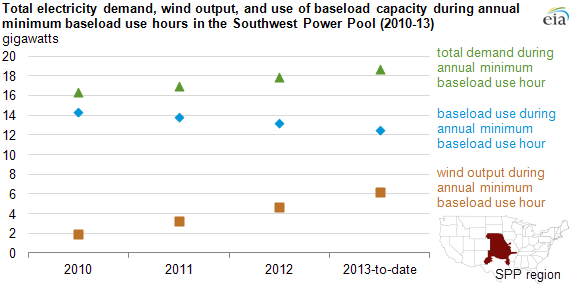The Energy Information Administration’s “Today in Energy” series shows with a couple of charts how growing wind power output in the Southwest Power Pool region is cutting into the income of baseload power plants.

The effect matters because baseload power plants tend to have the lowest operating costs. As baseload plants get pushed off the system, more of system capacity will shift to more flexible “load following” plants, which tend to have higher operating costs. Power prices in the Southwest Power Pool and other ISO power markets tend to reflect the operating costs of load following plants, so the effect will be to increase average wholesale power prices.
Wind power advocates sometimes want to claim credit for driving down power prices, and in the short run the addition of wind power can push prices down (especially, of course, if wind power plants have their output subsidized as with the Production Tax Credit). In the long run, as output of cheap-to-run baseload power plants is squeezed from the system, average prices will rise again.
The ERCOT market in Texas faces this same problem — in fact I suspect it is a little further down this path than the Southwest Power Pool — and the state has been struggling over projected resource adequacy concerns on the horizon. Of course, as Texas PUC commission Kenneth Anderson has pointed out, an efficient “energy-only” market with growing consumption should always see resource adequacy problems about four or five years ahead. If it doesn’t see shortages in the future, it implies the system is currently overbuilt. Still, incentives to invest in generation appear weak, wind power capacity additions in Texas are expected to continue, and resource adequacy analysts in ERCOT are nervous.